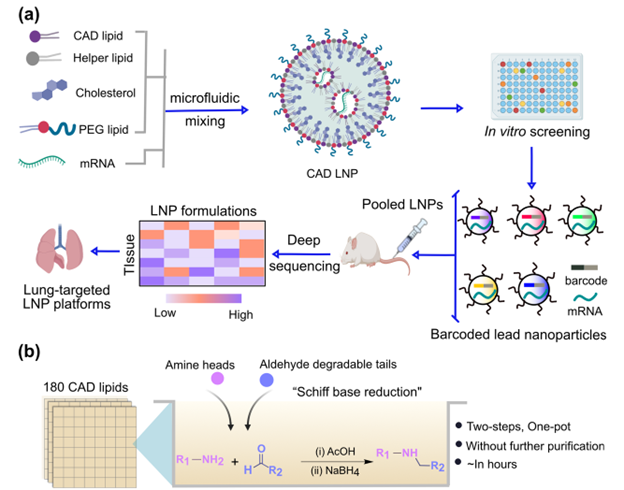Lung-targeting lipid nanoparticles allowing organ specific mRNA delivery for gene therapy applications.
Problem:
Gene therapy via mRNA delivery allows the rapid generation of therapeutics and vaccines for a wide range of applications. However, mRNA is especially vulnerable to degradation in the body, necessitating packaging within lipid nanoparticles. While these lipid nanoparticles protect mRNA and facilitate delivery, to date they act in a non-specific manner, entering cells regardless of therapeutic relevance.
Solution:
This library of lipids allows the production of lipid nanoparticles that specifically target the lungs. This allows lung-specific targeting of mRNA gene therapy, increasing the efficiency of gene delivery and improving therapeutic efficacy. Further, these lipid nanoparticles are readily biodegradable, ensuring they can be cleared from the body after delivering their mRNA payload.
Technology:
To identify lipid nanoparticles that exhibit organ-specific targeting, the inventors combined lipid materials to produce a total of 180 different lipid nanoparticle formulations. Using barcoded mRNA and genetic sequencing, the inventors were able to follow these lipid nanoparticles through the body and identify what lipids resulted in increased barcode distribution into the lungs. Top performers from this screen were further validated by using the lipid nanoparticles to guide expression of a bioluminescent reporter molecule, allowing visualization of the specific targeting of the lungs and cell types of transfections in the lungs. Leads loading CRISPR-based gene editors exhibited therapeutic potential for antiangiogenic cancer therapy within a lung tumor model in female mice.
Advantages:
- Lipid nanoparticles that specifically target lungs result in ~90% of total transfection observed in the lungs
- Biodegradable, dramatically enhancing safety profile
- Preferentially delivers mRNA to lungs at a clinically relevant dose of 0.3 mg/kg

Depiction of combinatorial synthesis and screening strategy to identify lung-targeting lipid nanoparticles. Synthesized lipids were used to form lipid nanoparticles which were loaded with barcoded mRNA, allowing deep sequencing to identify which lipids preferentially transfected lungs.
Case ID:
24-10568-TpNCS
Web Published:
10/17/2024
Patent Information:
| App Type |
Country |
Serial No. |
Patent No. |
File Date |
Issued Date |
Expire Date |